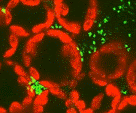Plant Pathology, Department of

Department of Plant Pathology: Faculty Publications
Document Type
Article
Date of this Version
2013
Citation
Plant Disease Management Reports 8, FC188 (2013).
Abstract
A foliar fungicide efficacy timing trial was conducted at the University of Nebraska-Lincoln South Central Agricultural Laboratory near Clay Center, NE. Corn hybrid NK ‘N68B’, rating of “fair” (7 out of 9) for gray leaf spot (GLS), not rated for common rust (CR), and “excellent” (2 out of 9) for southern rust (SR), was planted on 15 May in 30-in. rows at a target population of 31,763 plants/A. The trial area was disked with corn as the previous year’s crop. Nine treatments were replicated six times in a randomized complete block design. Each plot was four rows (10 ft) wide by 40 ft in length. . . . Gray leaf spot lesions were identified on the ear leaf by the 4 Sep assessment date. AUDPC calculations indicated all treatments statically reduced GLS severity compared to the nontreated control and fungicide treatments applied at V8 and reproductive stage R1 exhibited the lowest GLS AUDPC. Although not statistically different, treatments with an R1 fungicide application tended to have a slightly higher percent stay green. The nontreated control had the lowest percent lodging level. There were no significant differences among treatments for lodging. Grain moisture at harvest ranged from 14.7% to 15.0%. The nontreated control yielded 205.6 bu/A while Headline AMP 1.67 SC, 10 oz/A, R1 was the highest yielding foliar fungicide treatment at 209.3 bu/A. There were no significant differences in yield among treatments.


Comments
Copyright © 2013 The American Phytopathological Society. Used by permission.